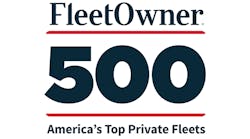Few outside of trucking, and even many in the industry, realize that America’s 500 largest private fleets operate 1.38 million trucks and tractors. For-hire carriers are undoubtedly the public face of trucking as they haul the lion’s share of freight in this country, yet private fleets run the overwhelming majority of commercial vehicles on our roads as they quietly fill critical support roles for all types of businesses. They carry field technicians and their tools to work sites, enable energy exploration and extraction, keep construction projects of all sizes supplied with raw materials, pick up and dispose of our trash, deliver fresh food to our store shelves, support manufacturing operations of all types, and generally underpin critical economic activity.
For the 14th year, the annual Fleet Owner 500 shines a light on these essential if underappreciated trucking operations, ranking the 500 largest by the number of tractors and trucks they operate and identifying the industries they serve. It’s compiled by FleetSeek.com from a database that’s constantly being updated through a variety of channels to create the most up-to-date list possible.
While last year’s report based on 2015 results showed major growth in the number of power units controlled by the Fleet Owner 500, this year there was virtually none with our truck and tractor totals only showing a 20,000-unit increase from the previous year’s 1.36 million. Given the relative sluggish economic climate in 2016, combined with a substantial falloff in in truck sales and a generally soft freight market, that isn’t much of a surprise.
However, while there was some pull-back in fleet size on the for-hire side in 2016, our 500 private fleets for the most part held course. In fact, the top 50 this year saw only one new name, and it was a fleet that came in at number 52 in the last report. Overall, there are only 10 new fleets in the 2017 rankings, and one of them was simply a name change.
The one clear growth trend in the fleet-size numbers was in the petroleum/gases category, perhaps indicating the long-awaited recovery in the oil and energy industries. Matching the steady recovery in housing and commercial real estate in 2016, a number of construction companies and utility providers also showed substantial additions to their fleets, though not at the levels reported in petroleum.
View more of the 2017 Fleet Owner 500
A breakdown of the Fleet Owner 500 by type
1-100 | 101-200 | 201-300 | 301-400 | 401-500
For those who want to share the Fleet Owner 500, reprints are available. A database version with more detailed fleet information is also available, as is online access to FleetSeek’s extensive data on both private and for-hire fleets. For ordering and price information, contact Reggie Lawrence at [email protected].



